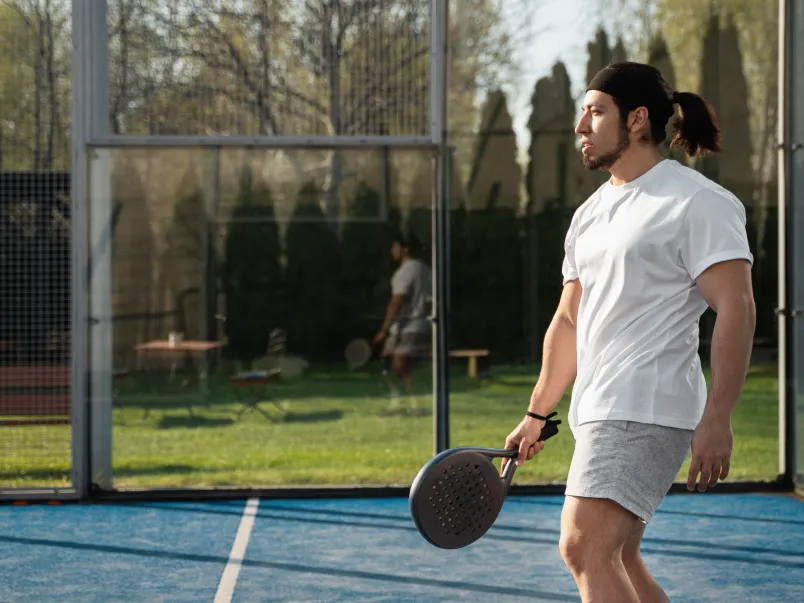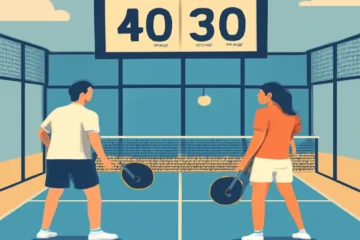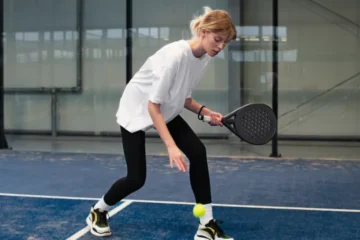In padel, the serve is not just a way to start the point — it’s the first tactical strike. A weak or inconsistent serve gifts your opponent an easy return, while a strong, well-placed serve gives you control from the very beginning. Unlike tennis, padel serves must be underhand and bounce once before hitting, which makes precision, spin, and disguise more important than raw power. So lets dive into How to Improve Your Padel Serve in 30 Days.
The serve is the only shot in padel you have 100% control over. There’s no rush, no ball coming at you, no opponent forcing you to react. It’s your moment. And yet, many padel players treat it casually, missing the chance to gain a huge advantage.
This article is your 30-day roadmap to serving improvement. Whether you’re a beginner struggling to get the ball in the box, or an intermediate player seeking more variation and confidence, this guide will walk you through drills, tips, and match-tested routines. By the end of these 30 days, you’ll not only serve with consistency but also with purpose.
Understanding the Fundamentals of a Padel Serve
Before diving into drills, let’s revisit the essentials.
Serve Rules in Padel
- The ball must bounce behind the service line before being struck.
- The serve is underhand — racket head below the waist at contact.
- The serve must go diagonally across into the opponent’s box.
- Like tennis, you get two attempts per point.
Key Elements of a Good Serve
- Controlled ball bounce: Keep it low and consistent.
- Solid contact point: Around knee-to-waist height.
- Steady stance and follow-through: No wobbling, no last-second jerks.
Common Mistakes
- Tossing (or bouncing) the ball too high or too far forward.
- Rushing the motion without rhythm.
- Moving your feet before striking, losing balance.
👉 Takeaway: If you don’t build on fundamentals, your serve will always collapse under pressure.
Days 1–2: Baseline Assessment
Improvement starts with measurement.
- Record Yourself: Place your phone behind you and hit 20 serves into each box. Watch later — the camera never lies.
- Track Results: Write down:
- How many serves land in.
- How many faults.
- How many serves hit intended targets (wide, body, T).
- Spot Weaknesses: Is it your bounce? Your timing? Do nerves make you rush?
💡 Pro Tip: Use a simple spreadsheet or notebook to log daily serve stats. This small habit helps you track progress and motivates you when improvement feels slow.

Week 1 (Days 3–7): Building a Solid Technique
Your first week focuses entirely on mechanics. Think of this as laying the foundation for a house — if it’s shaky, everything else crumbles.
Stance & Grip
- Stance: Stand sideways, with your front foot pointing toward the target corner. Keep weight balanced.
- Grip: Use the Continental grip (like holding a hammer). It gives control and allows you to add spin later.
Bounce & Timing Drill
- Let the ball bounce shoulder-width in front of you.
- Count “one… two” to slow down: one for the bounce, two for the hit. This prevents rushing.
Follow-Through Drill
- After contact, swing naturally upward and across, finishing with the racket pointing at your target zone.
Daily Routine (15 minutes)
- 5 minutes shadow serves (no ball, just motion).
- 30 serves aimed wide.
- 30 serves into body or T zone.
✅ Goal by end of Week 1: At least 60% first-serve success rate.
Also Read: Padel Rules Explained: A Beginner’s Guide
Week 2 (Days 8–14): Accuracy and Placement
Once technique feels steady, it’s time to sharpen your aim. Accuracy separates casual players from match-winners.
Serve Zones
- Wide Serve: Pulls opponent off court, leaving space for your next shot.
- Body Serve: Jams them in the ribs, forcing awkward returns.
- T Serve: Pins them down the middle, limiting angles.
Target Drill
- Place cones or water bottles in the service box.
- Aim 10 serves at each target.
- Track how many land within one racket-length.
Consistency Ladder Drill
- Serve 5 balls wide → 5 balls T → 5 balls body.
- Repeat without missing two in a row.
👉 Challenge yourself to complete the ladder under pressure. If you miss two, restart.
✅ Goal by end of Week 2: Place serves into 2 out of 3 intended targets consistently.
Week 3 (Days 15–21): Spin and Variation
Now that you’re consistent, it’s time to add disguise. Variation is what keeps opponents guessing.
Slice Serve
- Brush the side of the ball.
- Result: The ball stays low and skids after bouncing.
- Best when opponent stands deep.
Topspin Kick Serve
- Brush upward behind the ball.
- Result: Higher bounce, forcing opponent to hit upward, often weakly.
Flat Serve
- No spin — just pace and direction.
- Great as a surprise mix-up.
Mix-Up Strategy
Never give your opponent the same look twice in a row. Serve wide slice, then flat down the T, then topspin to body. Keep them uncomfortable.
Drill: Serve Roulette
- Write “Slice,” “Flat,” “Topspin” on slips of paper.
- Draw one before each serve.
- Forces variation under pressure.
✅ Goal by end of Week 3: Comfortable using at least 2 different serve types.
Week 4 (Days 22–28): Power, Consistency & Pressure Practice
Now comes the final polish — power and mental toughness.
Power Training (Off-Court)
- Resistance bands: Build shoulder stability.
- Wrist flicks: Strengthen control with light racket or dumbbell.
- Core rotations: Medicine ball twists for explosive power.
Volume Training (On-Court)
- Serve 100 balls daily (split into 5 sets of 20).
- Focus on rhythm, not brute force.
Pressure Drill: Double-Fault Challenge
- Simulate scoring. If you double-fault twice in a row, restart the set.
- Builds nerve control for match situations.
✅ Goal by end of Week 4: Land 70–80% of first serves even under pressure.
Days 29–30: Final Assessment
Time to see what 30 days of hard work has done.
- Re-record your serve under same conditions as Day 1.
- Compare stats: Consistency, accuracy, spin usage.
- Reflect: What’s improved most? What still needs work?
Even if your stats aren’t pro-level yet, you’ll notice smoother motion, better balance, and most importantly, confidence.
Mental & Tactical Aspects of the Serve
Serving isn’t just mechanics — it’s also psychology.
Pre-Serve Routine
Create a ritual: Bounce ball twice, take a breath, visualize target. Routines calm nerves.
Opponent Analysis
- If rival struggles on backhand → serve wide.
- If they crowd net → serve body to jam them.
- If they’re hesitant → mix slice and topspin.
Confidence Hacks
- Aim for high-percentage serves when nervous.
- Never chase aces in tight moments.
- Smile after faults — confidence is contagious.
👉 Remember: The serve is chess, not boxing. Outsmart, don’t out-muscle.
Bonus: Day-by-Day Mini Challenge Table
| Day | Focus | Drill/Action |
|---|---|---|
| 1–2 | Baseline | Record & log serve stats |
| 3–4 | Technique | Shadow swings + stance work |
| 5–7 | Placement | Target zones with cones |
| 8–10 | Accuracy | Consistency ladder drill |
| 11–14 | Control | Wide/Body/T variation |
| 15–17 | Spin | Slice serve practice |
| 18–20 | Variation | Serve Roulette |
| 21 | Match play | Practice in set play |
| 22–25 | Power | Resistance + serve reps |
| 26–28 | Consistency | 100 serves daily |
| 29 | Assessment | Video analysis |
| 30 | Match test | Play and track serve stats |
FAQs: How to Improve Your Padel Serve in 30 Days
Can you ace in padel?
Yes, though less common than tennis. A well-placed wide serve with slice can catch opponents off guard and count as an ace.
What’s the difference between first and second serve in padel?
Same rules apply, but most players take less risk on the second serve — aiming for consistency over power.
How do beginners avoid double faults?
Slow down. Focus on bounce control, not spin. Practice serving 50 balls in a row aiming only for consistency.
How often should I practice my serve?
Every session. Even 10 minutes of serving before matches builds habits.
What’s the best serve for padel beginners?
A simple flat serve aimed to the T or body. Once consistent, layer in slice and topspin.
Conclusion: A Better Serve, A Stronger Game
Your padel serve is no longer just a formality — it’s a weapon. In 30 days, you’ve built strong technique, sharpened accuracy, experimented with spin, and developed mental toughness. Keep logging your serves, keep practicing under match conditions, and your serve will continue to evolve.
Padel rewards players who build consistency brick by brick. Remember: one month is just the beginning. Keep at it, and soon your opponents will dread facing your serve.




